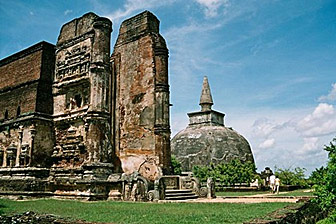Ceylon Sri Lanka and the earliest archaeological evidence of human colonization in Sri Lanka appears at the site of Balangoda. Balangoda Man arrived on the island about 34,000 years ago and have been identified as Mesolithic hunter gatherers who lived in caves. Several of these caves, including the well known Batadombalena and the Fa-Hien Rock cave, have yielded many artifacts from these people who are currently the first known inhabitants of the island.
Balangoda Man probably created Horton Plains, in the central hills, by burning the trees in order to catch game. However, the discovery of oats and barley on the plains at about 15,000 BC suggests that agriculture had already developed at this early date.
Several minute granite tools (about 4 centimetres in length), earthenware, remnants of charred timber, and clay burial pots date to the Mesolithic stone age. Human remains dating to 6000 BC have been discovered during recent excavations around a cave at Varana Raja Maha vihara and in the Kalatuwawa area. Reference : Wikipedia – Sri Lanka.
From Ceylonese to Sri Lankan
Ceylonese history. This connection was even stronger during the British colonial period. Under British rule, the monasteries lacked official status and were unable to defend their land or rights. One report claimed that 800,000 acres of temple property were confiscated. The colonial government and the Christian missionaries took the entire school system out of the hands of the Buddhists. The Buddhists became second-class citizens, while the Christians and the English-educated rose to the best positions in the colonial administration. Only Christian Sundays and feast days and the British national holidays were celebrated in this Buddhist country. There were various anti-colonialist uprisings and prominent Buddhist monks were condemned to death. Threats of religious, national and cultural effacement like these led to the Buddhist revival in Ceylon.

Among Ceylonese scholars, it should be noted that lay Buddhists have played no less important a part in Buddhist literary activities than the monks. One of the best known or, probably, the best known, should be Professor G.P. Malalasekera, the compiler of the Dictionary of Pali Proper Names (2480-2481/1937-38) and Editor-in-Chief of the Encyclopaedia of Buddhism, the first fascicule of which was published in 2504/1961. The Encyclopaedia is a work of international collaboration and several regional committees have been set up for the better coordination of the work, the largest of these being the Japanese committee. Smaller committees also function in China, Burma, Thailand, Germany, France, Italy and the Netherlands. Some 2,000 pages of the Encyclopaedia have been published so far.
Thanks Source : budsas.org
